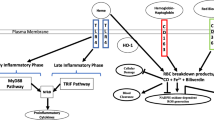Abstract
Experimental and clinical data suggest that iron has a key role in cerebral ischaemia. We measure infarct volume and analyse the nitric oxide responses to brain injury in rat stroke model after increased oral iron intake. Permanent middle cerebral artery occlusion (MCAO) was performed in a group of 20 male Wistar rats, 10 of which were fed with a control diet and 10 of which were fed with iron-enriched diet containing 2.5% carbonyl iron for 9 weeks. L-arginine and nitric oxide metabolites were determined in blood samples before and at 2, 6, 8 and 48 h after MCAO. Infarct volume, thiobarbituric acid reaction substances (TBARS) and tissue iron were measured at 48 h. Infarct volume was 66 % greater in the iron-fed rats than in the control group. Iron-fed animals showed significantly higher levels of TBARS. Liver iron stores (3500±199 vs 352±28 μg Fe/g, p<0.0001) but not brain iron stores (131±11 vs 139±8 μg Fe/g, p=0.617), were significantly higher in the iron-fed group. L-arginine levels were slightly lower in iron-fed rats and decreased significantly in both groups at 6 and 8 hours after MCAO. The levels of the stable end products of NOS (NOx=nitrite + nitrate) were significantly higher in iron-fed rats before MCAO (16.2 ± 2.2vs. 9.6±0.8 μmol. L−1, p<0.05), with a further increase during the six first hours after MCAO in both groups. These results suggest that the iron overload that increases both superoxide and nitric oxide production leads to peroxynitrite formation, thus enhancing brain damage.
Resumen
Datos experimentales y clínicos sugieren que el hierro tiene un papel importante en la isquemia cerebral. En este trabajo, se valora la participación del óxido nítrico en la lesión cerebral producida por la oclusión permanente en la arteria cerebral media en ratas alimentadas con una dieta suplementada con hierro (2.5 % de hierro carbonilo) durante 9 semanas y en ratas alimentadas con una dieta estándar. Se analizan muestras de sangre, obtenidas antes y a las 2, 6, 8 y 48 horas del infarto, para valorar la L-arginina y los metabolitos del óxido nítrico. El volumen del área infartada, las sustancias que reaccionan con el ácido tiobarbitúrico (TBARS) y el contenido de hierro en los tejidos se determinan a las 48 horas del infarto. En ratas suplementadas con hierro, el volumen del infarto es un 66 % mayor que en el grupo control (178±49 mm3 vs 107±53 mm3, p<0.01) y los niveles de TBARS son significativamente superiores (6.52±0.59 vs 5.62±0.86 μmol.L−1, p=0.03). El contenido de hierro en el hígado (3500±199 vs 352±28 μg Fe/g, p<0.0001), no el del tejido cerebral (131±11vs 139±8 μg Fe/g, p=0.617), es superior en el grupo alimentado con la dieta con hierro. La concentración de la L-arginina basal es significativamente menor en las ratas alimentadas con hierro. Producido el infarto, la L-arginina disminuye significativamente en ambos grupos a las 6 y 8 horas. Los niveles de NOx son significativamente mayores en las ratas alimentadas con la dieta con hierro (16.2±2.2vs 9.6±0.8 μm.L−1, p<0.05), con un aumento en ambos grupos durante las 6 primeras horas después del infarto. Los resultados sugieren que la sobrecarga sistémica de hierro aumenta tanto la producción de superóxido como la de NO. Ambos metabolitos producen peroxinitrito, contribuyendo así a un mayor daño cerebral.
Similar content being viewed by others
References
Anwa-r, M., Costa, O., Sinha, A. K. and Weiss, H. R. (1993);Neurol. Res.,15, 232–236.
Brissot, P., Zanninelli, G., Guydayer, D., Zeind, J. and Gollan, J. L. (1994):Am. J. Physiol.,267, 135–142.
Bulkley, G. B. (1994):Lancet,334, 934–936.
Castellanos, M., Puig, N., Carbonell, T., Castillo, J., Martinez, J. M., Rama, R. and Dávalos, A. (2002);Brain Res.,952, 1–6.
Castillo, J., Dávalos, A. and Noya, M. (1997):Lancet,349, 79–83.
Castillo, J., Rama, R., and Dávalos, A. (2000):Stroke,31, 852–857.
Choi, D. W. (1988):Neuron,1, 623–634.
Dávalos, A., Castillo, J., Marrugat, J., Fernández-Real J. M., Armengou, A., Cacabelos, P. and Rama, R. (2000):Neurology,54, 1568–1574.
Dirnagl, U., Iadecola, C. and Moskowitz, M. (1999):Trends Neurosci.,23, 391–397.
Eliasson, M., Huang, Z., Ferrante, R., Sasamata, M., Molliver, M., Snyder, S. and Moskovitz, M. (1999):J. Neuroscience,19, 5910–5918.
Galleano, M. and Puntarulo, S. (1997):Toxicology,19, 73–81.
Iadecola, C. (1997):Trends Neurosci.,20, 132–139.
Kumura, E. (1996):Am. J. Physiol.,270, 748–752.
Lee, J.-M., Grabb, M., Zipfel, G. and Choi, D. W. (2000):J. Clin. Invest.,106, 723–731.
Mayhan, W. G. (2000):Brain Res.,866, 101–108.
Mayhan, W. G. and Didion S. (1996):Stroke,27, 965–970.
Patt, A., Horesh, I. R., Berger, E. M., Harken, A. H. and Repine, J. E. (1990):J. Pediatr. Surg.,25, 224–228.
Ryan, T. and Aust, S. (1992):Crit. Rev. Toxicol.,22, 119–141.
Samdami, A., Dawson, T. M. and Dawson, V. L. (1997):Stroke,28, 1283–1288.
Schmidley, J. W. (1990):Stroke,25, 7–12.
Shoham, S. and Youdim, M. B. (2000):Cell. Mol. Biol.,46, 743–760.
Taylor, E. M., Crowe, A. and Morgan E. H. (1991):J. Neurochem.,57, 1584–1592.
Winterbourn, C. C. (1995):Toxicol. Lett.,82–83, 969–974.
Author information
Authors and Affiliations
Rights and permissions
About this article
Cite this article
Gámez, A., Carbonell, T. & Rama, R. Does nitric oxide contribute to iron-dependent brain injury after experimental cerebral ischaemia?. J. Physiol. Biochem. 59, 249–254 (2003). https://doi.org/10.1007/BF03179881
Received:
Issue Date:
DOI: https://doi.org/10.1007/BF03179881




